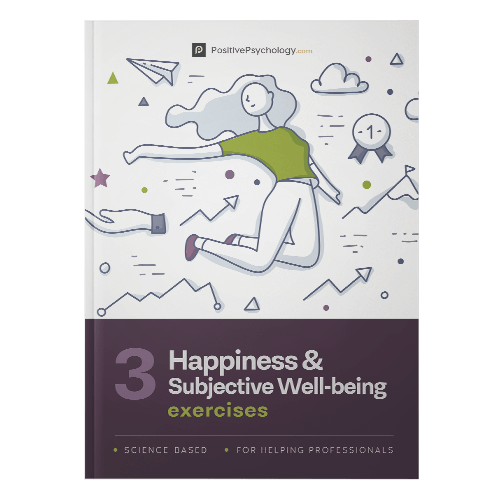What Is Mental Wellbeing? A Psychologist Explains
 Have you ever noticed how everything seems manageable when you’re in a good mood?
Have you ever noticed how everything seems manageable when you’re in a good mood?
Or how a problem doesn’t seem so serious after you’ve woken up from a good rest? Ever noticed how a phone call to a friend makes you feel so much better?
The effects of our mental health are experienced in every aspect of our lives. Our moods, physical health, and social connections help us cope better with adversity and unexpected hurdles. Together, they contribute to our sense of wellbeing and our mental health.
By taking a proactive stance of improving, maintaining, and nurturing our mental health, we can ensure that we live healthy, productive, and meaningful lives.
This post will help you better understand the concept of mental wellbeing and identify its benefits. Finally, we’ll end with some useful tools that can improve your clients’ mental wellbeing.
Before you continue, we thought you might like to download our three Happiness & Subjective Wellbeing Exercises for free. These detailed, science-based exercises will help you or your clients identify sources of authentic happiness and strategies to boost wellbeing.
This Article Contains:
What Are Mental Wellbeing and Mental Health?
The terms ‘mental wellbeing’ and ‘mental health’ are important concepts that are difficult to define.
Definition of mental health
The World Health Organization (2004) defines mental health in the following way:
- It is a state of wellbeing,
- in which the individual realizes their abilities,
- can cope with the normal stresses of life,
- can work productively and fruitfully, and
- can contribute to their community.
Other terms that might be used in the literature include positive mental health, mental capital, and wellbeing, which can be psychological, mental, or subjective (de Cates, Stranges, Blake, & Weich, 2015).
Challenges to the definition of mental health
There are some challenges to the definition of mental health and what it means to be mentally healthy (de Cates et al., 2015; Fusar-Poli et al., 2020).
Mental health is framed as part of a larger set of behaviors that result in a healthy, happy, and meaningful existence (World Health Organization, 2004). Together with physiological health, mental health is considered part of the broader concept of health. However, the determinants of physical health and psychological health are different.
Specifically, to be physically healthy typically implies the absence of illness (Fusar-Poli et al., 2020). The World Health Organization (2004) states that mental health is not limited to the absence of mental illnesses or diseases. For example, just because an MRI scan shows that there are no abscesses or tumors present, it doesn’t imply that someone is mentally healthy.
These two concepts – mental wellbeing and mental illness – are not dependent on each other (de Cates et al., 2015). This implies that patients can present with mental illness and also have high levels of mental wellbeing.
At one point, mental health was considered a collection of symptoms of positive feelings and positive functioning (Keyes, 2002). Keyes (2002) argued that mental health could be measured on a continuum: one end anchored with the presence of mental disorders, and the other, with mental wellbeing.
However, subsequent research now considers mental wellbeing as a separate concept from mental illness and mental distress (see the discussion in de Cates et al., 2015).
For example, patients may experience mental distress in response to stressful events. However, their distress can be considered a normal reaction and a healthy coping mechanism. An example of this is a patient who is grieving. Feelings of grief and possibly depression are normal responses to loss.
Definitions of mental health are also influenced by social, cultural, and historical variables (de Cates et al., 2015). Here are two examples:
- Cultures that value independence and autonomy may have different concepts of mental health compared to cultures that favor behavior that benefits the community.
- The understanding of mental health and the factors that affect it is influenced by time and societal changes. For example, burnout has been recognized as an occupational phenomenon that arises from poorly managed work stress. However, ‘occupational stress’ didn’t exist as a psychological construct before the 40-hour workweek was introduced. In this instance, the concept of occupational stress came into existence when work hours became more structured, and the concept of an ‘occupation’ was born (Weber & Jaekel-Reinhard, 2000).
5 Examples of Mental Wellbeing

Subjective wellbeing is defined as our perception and evaluation of our life (Keyes, 2006).
Two components comprise subjective wellbeing: hedonia and eudaimonia.
- Hedonia (like the word ‘hedonism’) refers to pleasure and happiness. In the context of mental wellbeing, it means feeling happy about one’s life and enjoying experiences that cause happiness.
- Examples of hedonia include any activities that cause happiness. For some people, this might be enjoying food and wine; for other people, this might be reading books or watching films.
- Eudaimonia is a slightly more complex concept, but it refers to living a meaningful life and striving to reach one’s full potential.
- Examples of eudaimonia include finding meaning, completing goals, feeling like one contributes to society, being challenged, and having a sense of purpose.
Together, these two concepts contribute to our understanding of mental wellbeing.
Other definitions of mental wellbeing highlight other behaviors and activities. For example, Ryff (1989; 2013) argues that mental wellbeing comprises six sub domains:
- Believing that your life has meaning
- Continued self-development and growth
- Good-quality social connections
- Believing that you can overcome hurdles
- Having a positive self-concept
- Having a sense of purpose
5 Examples of positive wellbeing
Here are five examples of how positive mental wellbeing can manifest:
- Annie is busy changing jobs. Although she is moving into a different field, she feels confident in her ability to navigate these new challenges.
- Although Jacob is retired and lives alone, he has strong ties to his community. He participates in his church, plays boules regularly for his local club, and volunteers for the local park committee.
- Mikaela has recently discovered a love for pottery, and she’s good at it. She attends a local pottery class every week, and now she teaches pottery at the local school. She enjoys teaching children, and she is very committed to her new role as a potter.
- Malcolm is running late for his meeting. Instead of chastising himself for his tardiness, he reminds himself that some things are outside his control. He notifies his work colleagues and asks them to wait 15 minutes. He doesn’t integrate his tardiness in his self-concept, and he makes a point of not being late in the future.
- Simone is a homemaker. She has more free time now that her children have moved out. She starts learning a new language and enrolls in community college. Even though she’s an older student, she thoroughly enjoys her classes and works hard. The feedback from her professors and her friendships in her class reinforce her sense of purpose.
Why Is Mental Wellbeing Important?
Mental health is as important as general physical health (World Health Organization, 2004).
Global impact of mental illnesses and disorders
Of the global prevalence of illnesses, mental disorders and illnesses make up 14% of the burden of disease (Prince et al., 2007).
The World Health Organization estimates that the prevalence of mental illnesses has increased substantially and that approximately 20% of youth experience mental disorders (World Health Organization, n.d.).
To measure the impact of mental illnesses and disorders, we can use the concept of disability-adjusted life years (Mathers & Loncar, 2006). This measurement is the total number of years that someone spent living with a disability or that were ‘lost’ to living with consequences of certain illness (Keyes, 2013).
Higher numbers are more serious and indicate a higher impact. It is estimated that by 2030, the percentage of disability-adjusted life years that can be attributed to mental, behavioral, and neurological disorders will be almost 15% globally, but this pattern of prevalence will differ among high-income, middle-income, and low-income countries (Prince et al., 2007).
The prevalence will be highest among high-income countries, with mental, behavioral, and neurological disorders accounting for approximately 30% of disability-adjusted life years. Additionally, it is estimated that the number of disability-adjusted life years attributed to mental, behavioral, and neurological disorders in older adults will increase by 79.5% in 2030 (Prince et al., 2015).
Specific mental illnesses and disorders that are expected to contribute to disability-adjusted life years include the following:
- Self-inflicted injuries (e.g., suicide)
- Alzheimer’s disease and other types of dementia
- Illnesses related to alcohol use
Impact of psychological health on other areas of life
Physical and psychological health are not considered two mutually exclusive concepts. Rather, good physical health can lead to good mental health, a good life, and vice versa.
For example, low mood, which indicates low mental health, is associated with an increased risk of stroke (Nabi, Kivimaki, De Vogli, Marmot, & Singh-Manoux, 2008; Surtees et al., 2008).
Physical health is not the only major domain of our lives affected by mental health. Good mental health also affects our workplace and our productivity, which affects society. For example, employees who work in stressful work environments can experience burnout. As a result, they are less likely to enjoy their jobs and can develop other illnesses.
We’ll talk more about this below in A Note on Mental Wellbeing at Work.
By focusing on mental health in a proactive and preventative manner, people might be able to avoid or lessen the severity of mental illnesses and disorders, or reduce the impairments in other areas of life, such as physical health and work (Barry, 2001).
Rather than waiting for patients to develop a psychological disorder before treating their symptoms, it is important to teach patients healthy techniques, behaviors, and strategies to cope with adversity and stress as part of a holistic plan to ensure a healthy lifestyle as a way of achieving mental wellbeing.
5 Scientifically Proven Benefits
Before we list the benefits linked to mental wellbeing, we should discuss some limitations in current literature.
Limitations of the existing literature
Research on mental wellbeing and mental health typically focuses on the lack of mental wellbeing or negative mental health, rather than positive mental wellbeing and positive mental health (Fusar-Poli et al., 2020).
This is because research is often unclear about the following:
- What is meant by ‘mental health’
- What adequate levels of mental health are
- How mental health is related to mental distress and mental illness
Instead, it is easier to measure anxiety, depression, sadness, anger, and other negative feelings and behaviors, and assume that the presence of these suggests negative mental wellbeing. For these reasons, most extant research focuses on negative mental health and its effects.
Despite these challenges, there is a set of studies that look at the benefits associated with happiness, subjective wellbeing, and mental wellbeing.
Most of these are cross-sectional studies, so the direction of the relationship between mental wellbeing and a particular circumstance is not clear. Did happiness cause this circumstance, did this circumstance cause happiness, or is there a third variable involved?
Unfortunately, cross-sectional studies cannot prove causality. Keep this limitation in mind when reading these studies and the results below.
Benefits of positive mental wellbeing
We’ve adopted a holistic approach to the concept of mental wellbeing and mental health, which includes happiness, resilience, and confidence. Using this holistic approach, here is a list of benefits associated with mental wellbeing.
- Happiness is associated with positive outcomes including better relationships, higher income, better mental health, and longevity (Lyubomirsky, King, & Diener, 2005).
- Happier people take part in more altruistic activities and volunteering (Diener & Tov, 2007; Tov & Diener, 2009).
- Happier people show attitudes that promote social cohesion and civility. For example, they trust more easily, are more likely to cooperate and support pro-peace or anti-war efforts, have more confidence in their government, and have more confidence in democracy. They are also more tolerant of immigrants and people from different demographic groups (Diener & Tov, 2007; Tov & Diener, 2009). These findings are present at both an individual level and a societal level (Tov & Diener, 2009). In other words, happier societies are more confident and trusting of their governments.
- People with better mental health are more likely to exercise, which has a positive knock-on effect on physical health (Gerber & Pühse, 2009; Ohrnberger, Fichera, & Sutton, 2017).
- As mental health increases, cigarette use decreases. Reduced cigarette use results in better physical health (Ohrnberger et al., 2017).
Why is it that positive mental wellbeing results in positive circumstances? Lyubomirsky et al. (2005) posit that positive emotions and mood allow us to interpret situations in a more positive light and adopt better attitudes toward learning and experiences.
As a result, positive emotions and moods allow people to:
- Act in ways that help them reach their goals
- Increase resources for future adversity
- Get enough rest
- Work toward other goals
- Increase skills
- Meet new people
Workplace mental health – all you need to know (for now) – Tom Oxley
A Note on Mental Wellbeing at Work
Mental wellbeing is an important contributor to workplace productivity, success, and job satisfaction (Cleary, Schafer, McLean, & Visentin, 2020; LaMontagne, Keegel, & Vallance, 2007). There are many ways in which factors in the workplace can contribute toward mental wellbeing (Chopra, 2009; LaMontagne et al., 2007; Weber & Jaekel-Reinhard, 2000).
Examples include good professional relationships, clear feedback and instructions, positive feedback, and work–life balance. In contrast, factors such as poor or unclear communication, unrealistic deadlines, poor relationships and workplace conflict, and a lack of support can cause negative mental wellbeing.
The long-term consequence of negative working conditions is burnout, where the employee feels uninvested in their work; is continuously fatigued; and adopts a negative attitude toward themselves, their work product, and their colleagues. One outcome of burnout is resignation.
PositivePsychology.com’s Relevant Tools
Here are some useful tools that address different aspects of mental wellbeing.
The Basic Needs Satisfaction Scale is a validated 21-item assessment allowing practitioners to assess the extent to which a client’s core needs for autonomy, competence, and relatedness are generally satisfied in their life. Using the results of the tool, you can work with the client to identify which domains of their life are neglected and together develop a program to improve those subdomains.
If your client is struggling to cope with adversity, then you might find the Exploring Past Resilience tool helpful. This tool is a useful exercise where your client can consider resilience resources and strategies that have helped them overcome difficulties in the past.
A similar tool is the Nurturing vs. Depleting Activities worksheet. In this exercise, your client can reflect on whether their daily activities are nurturing or depleting. In doing so, they can develop ways to incorporate more nurturing activities into their lives for improved self-care.
Once the factors and their relationships have been identified, a pattern might become clear. Perhaps there is a specific factor that is influencing the network of factors disproportionately. Once these highly influential factors have been identified, you and the client can work together to identify the way forward.
If you’re looking for more science-based ways to help others develop strategies to boost their wellbeing, this collection contains 17 validated happiness and wellbeing exercises. Use them to help others pursue authentic happiness and work toward a life filled with purpose and meaning.
A Take-Home Message
Even though your client may not experience any symptoms of a psychological or physical illness, this does not mean that they are necessarily healthy. For example, your client might engage in behaviors that promote negative mental health or continue to feel dissatisfied in their life.
Since mental health is a complex construct that embraces many subdomains, it’s easier to focus on each subdomain individually. For example, your client might have strong social connections but be unhappy at work. Or they might feel like they have a purpose yet feel like they cannot cope with unexpected adversity.
Improvement in any of the subdomains should improve your client’s sense of wellbeing and promote their overall mental health.
The benefits of mental health extend beyond the client and will also be experienced in their family life, workplace, and ultimately their society. And for these same reasons, your mental wellbeing will positively affect your client’s wellbeing too. So make sure to read our Self-Care Tips for Therapists to look after your own wellbeing.
We hope you enjoyed reading this article. Don’t forget to download our three Happiness Exercises for free.
- Barry, M. M. (2001). Promoting positive mental health: Theoretical frameworks for practice. International Journal of Mental Health Promotion, 3(1), 25–34.
- Chopra, P. (2009). Mental health and the workplace: Issues for developing countries. International Journal of Mental Health Systems, 3(1), 1–9.
- Cleary, M., Schafer, C., McLean, L., & Visentin, D. C. (2020). Mental health and well-being in the health workplace. Issues in Mental Health Nursing, 41(2), 172–175.
- de Cates, A., Stranges, S., Blake, A., & Weich, S. (2015). Mental well-being: An important outcome for mental health services? The British Journal of Psychiatry, 207(3), 195–197.
- Diener, E., & Tov, W. (2007). Subjective well‐being and peace. Journal of Social Issues, 63(2), 421–440.
- Fusar-Poli, P., de Pablo, G. S., De Micheli, A., Nieman, D. H., Correll, C. U., Kessing, L. V., … van Amelsvoort, T. (2020). What is good mental health? A scoping review. European Neuropsychopharmacology, 31, 33–46.
- Gerber, M., & Pühse, U. (2009). Do exercise and fitness protect against stress-induced health complaints? A review of the literature. Scandinavian Journal of Public Health, 37(8), 801–819.
- Keyes, C. L. M. (2002). The mental health continuum: From languishing to flourishing in life. Journal of Health and Social Behavior, 43, 207–222.
- Keyes, C. L. M. (2006). Subjective well-being in mental health and human development research worldwide: An introduction. Social Indicators Research, 77(1), 1–10.
- Keyes, C. L. M. (2013). Promoting and protecting positive mental health: Early and often throughout the lifespan. In C. L. M. (Ed.), Mental well-being: International contributions to the study of positive mental health (pp. 3–28). Springer Science + Business Media.
- LaMontagne, A. D., Keegel, T., & Vallance, D. (2007). Protecting and promoting mental health in the workplace: Developing a systems approach to job stress. Health Promotion Journal of Australia, 18(3), 221–228.
- Lyubomirsky, S., King, L., & Diener, E. (2005). The benefits of frequent positive affect: Does happiness lead to success? Psychological Bulletin, 131(6), 803.
- Mathers, C. D., & Loncar, D. (2006). Projections of global mortality and burden of disease from 2002 to 2030. PLoS medicine, 3(11), e442.
- Nabi, H., Kivimaki, M., De Vogli, R., Marmot, M. G., & Singh-Manoux, A. (2008). Positive and negative affect and risk of coronary heart disease: Whitehall II prospective cohort study. British Medical Journal, 337.
- Ohrnberger, J., Fichera, E., & Sutton, M. (2017). The relationship between physical and mental health: A mediation analysis. Social Science & Medicine, 195, 42-49.
- Prince, M., Patel, V., Saxena, S., Maj, M., Maselko, J., Phillips, M. R., & Rahman, A. (2007). No health without mental health. The Lancet, 370(9590), 859–877.
- Prince, M. J., Wu, F., Guo, Y., Robledo, L. M. G., O’Donnell, M., Sullivan, R., & Yusuf, S. (2015). The burden of disease in older people and implications for health policy and practice. The Lancet, 385(9967), 549–562.
- Ryff, C. (1989). Happiness is everything, or is it? Explorations on the meaning of psychological well-being. Journal of Personality and Social Psychology, 57, 1069–1081.
- Ryff, C. D. (2013). Psychological well-being revisited: Advances in the science and practice of eudaimonia. Psychotherapy and Psychosomatics, 83(1), 10–28.
- Ryff, C., & Keyes, C. (1995). The structure of psychological well-being revisited. Journal of Personality and Social Psychology, 69, 719–727.
- Surtees, P. G., Wainwright, N. W. J., Luben, R. N., Wareham, N. J., Bingham, S. A., & Khaw, K. T. (2008). Psychological distress, major depressive disorder, and risk of stroke. Neurology, 70(10), 788–794.
- Tov, W., & Diener, E. (2009). The well-being of nations: Linking together trust, cooperation, and democracy. In E. Diener (Ed.), The science of well-being: The collected works of Ed Diener (pp. 155–173). Springer.
- Weber, A., & Jaekel-Reinhard, A. (2000). Burnout syndrome: a disease of modern societies? Occupational Medicine, 50(7), 512–517.
- World Health Organization (n.d.). Mental health. Retrieved February 9, 2021, from https://www.who.int/health-topics/mental-health#tab=tab_2.
- World Health Organization. (2004). Promoting mental health: Concepts, emerging evidence, practice: Summary report. Retrieved February 19, 2021, from https://www.who.int/mental_health/evidence/en/promoting_mhh.pdf.
Let us know your thoughts
Read other articles by their category
- Body & Brain (49)
- Coaching & Application (57)
- Compassion (26)
- Counseling (51)
- Emotional Intelligence (24)
- Gratitude (18)
- Grief & Bereavement (21)
- Happiness & SWB (40)
- Meaning & Values (26)
- Meditation (20)
- Mindfulness (45)
- Motivation & Goals (45)
- Optimism & Mindset (34)
- Positive CBT (28)
- Positive Communication (20)
- Positive Education (47)
- Positive Emotions (32)
- Positive Leadership (18)
- Positive Parenting (4)
- Positive Psychology (33)
- Positive Workplace (37)
- Productivity (16)
- Relationships (46)
- Resilience & Coping (36)
- Self Awareness (21)
- Self Esteem (38)
- Strengths & Virtues (32)
- Stress & Burnout Prevention (34)
- Theory & Books (46)
- Therapy Exercises (37)
- Types of Therapy (64)






What our readers think
Corey Keyes also “considers mental wellbeing as a separate concept from mental illness and mental distress.” He does not see them on one continuum.
Very informative
Mental health is real i can see sometimes and it lead to a depression
Get knowledge and certificates